Dark fantasy
Dark fantasy is a subgenre of fantasy literary, artistic, and cinematic works that incorporate darker and frightening themes of fantasy. It also often combines fantasy with elements of horror or has a gloomy, dark tone, or a sense of horror and dread.[1]
| Fantasy |
|---|
 |
| Media |
|
| Genre studies |
| Subgenres |
|
| Fandom |
| Categories |
|
|
Definition
A strict definition for dark fantasy is difficult to pin down. Gertrude Barrows Bennett has been called "the woman who invented dark fantasy".[2] Both Charles L. Grant[3] and Karl Edward Wagner[4] are credited with having coined the term "dark fantasy"—although both authors were describing different styles of fiction. Brian Stableford argues "dark fantasy" can be usefully defined as subgenre of stories that attempt to "incorporate elements of horror fiction" into the standard formulae of fantasy stories.[1] Stableford also suggests that supernatural horror set primarily in the real world is a form of "contemporary fantasy", whereas supernatural horror set partly or wholly in "secondary worlds" should be described as "dark fantasy".[1]
Additionally, other authors, critics, and publishers have adopted dark fantasy to describe various other works. However, these stories rarely share universal similarities beyond supernatural occurrences and a dark, often brooding, tone. As a result, dark fantasy cannot be solidly connected to a defining set of tropes. The term itself may refer collectively to tales that are either horror-based or fantasy-based.
Some writers also use "dark fantasy" (or "Gothic fantasy") as an alternative description to "horror", because they feel the latter term is too lurid or vivid.[5]
Concept and history
Charles L. Grant is often cited as having coined the term "dark fantasy". Grant defined his brand of dark fantasy as "a type of horror story in which humanity is threatened by forces beyond human understanding".[3] He often used dark fantasy as an alternative to horror, as horror was increasingly associated with more visceral works.
Dark fantasy is sometimes also used to describe stories told from a monster's point of view, or that present a more sympathetic view of supernatural beings usually associated with horror. Anne Rice's The Vampire Chronicles, Chelsea Quinn Yarbro's Saint-Germain,[6] and Neil Gaiman's The Sandman are early examples of this style of dark fantasy. This is in contrast to the traditional horror model, which focuses more on the victims and survivors.
In a more general sense, dark fantasy is occasionally used as a synonym for supernatural horror, to distinguish horror stories that contain elements of the supernatural from those that do not. For example, a story about a werewolf or vampire could be described as dark fantasy, while a story about a serial killer would simply be horror.[7]
Stableford suggests that the type of horror conveyed by fantasy stories such as William Beckford's Vathek and Edgar Allan Poe's The Masque of the Red Death "is more aesthetic than visceral or existential", and that such stories should be considered "dark fantasies" rather than the "supernaturalized thrillers" of conventional horror fiction.[5]
Karl Edward Wagner is often credited for creating the term "dark fantasy" when used in a more fantasy-based context.[4] Wagner used it to describe his fiction about the Gothic warrior Kane. Since then, "dark fantasy" has sometimes been applied to sword and sorcery and high fantasy fiction that features anti-heroic or morally ambiguous protagonists.[1] Another good example under this definition of dark fantasy is Michael Moorcock's saga of the albino swordsman Elric.[6]
The fantasy work of H. P. Lovecraft, Clark Ashton Smith and their emulators have been specified as "dark fantasy", since the imaginary worlds they depicted contain many horror elements.[1] This horror element is prevalent in some sub-genres of anime.
Dark fantasy is occasionally used to describe fantasy works by authors whom the public primarily associates with the horror genre. Examples of these are Stephen King's The Dark Tower series,[6] Peter Straub's Shadowland[8] and Clive Barker's Weaveworld.[6] Alternatively, dark fantasy is sometimes used for "darker" fiction written by authors best known for other styles of fantasy; Raymond Feist's Faerie Tale[8] and Charles de Lint's novels written as Samuel M. Key[9] would fit here.
See also
- Category:Dark fantasy role-playing games
- Dystopian
- Gothic fiction
- Grimdark
- Horror fiction
- List of genres
- Mecha
- Paranormal fiction
- Occult detective
- Science fantasy
- Splatterpunk
- Supernatural fiction
- Sword and sorcery
- Urban fantasy
- Weird fiction
References
- Stableford, Brian, "Dark Fantasy", in The A to Z of Fantasy Literature,(p. 97) , Scarecrow Press,Plymouth. 2005. ISBN 0-8108-6829-6
- "The Woman Who Invented Dark Fantasy" by Gary C. Hoppenstand from Nightmare and Other Tales of Dark Fantasy by Francis Stevens, University of Nebraska Press, 2004, page x. ISBN 0-8032-9298-8.
- The Greenwood Encyclopedia of Science Fiction and Fantasy: Themes, Works, and Wonders, Volume 1, edited by Gary Westfahl, Greenwood Publishing Group, 2005.
- "Karl Edward Wagner". Darkecho.com. Archived from the original on 2012-05-11. Retrieved 2014-03-21.
- Stableford, Brian, "Horror", in The A to Z of Fantasy Literature,(p. 204), Scarecrow Press, Plymouth. 2005. ISBN 0-8108-6829-6
- "Dark Fantasy | Williamsburg Regional Library". Wrl.org. Retrieved 2014-03-21.
- "Fantasy Subgenres: Dark Fantasy". Nvcc.edu. 2007-06-20. Archived from the original on 2011-11-10. Retrieved 2014-03-21.
- Clute, John and Grant, John. The Encyclopedia of Fantasy (2nd US edition). New York: St Martin's Griffin, 1999.
- Craig Clarke. "Charles de Lint (writing as Samuel M. Key), Angel of Darkness". Greenmanreview.com. Archived from the original on 2012-05-29. Retrieved 2014-03-21.
External links
- "On Dark Fantasy"—author Lucy Snyder's essay on the differences between "pure" horror and dark fantasy.